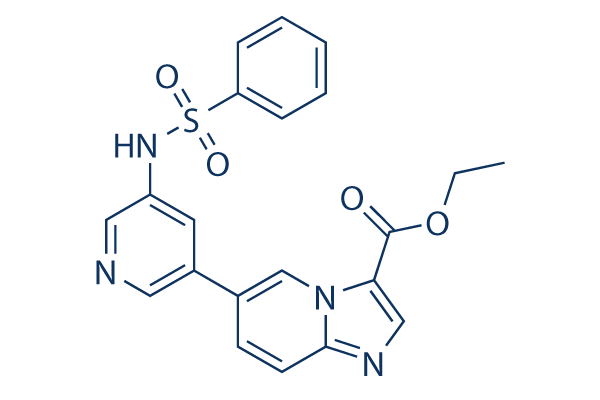| Cas No.: | 1276110-06-5 |
| Chemical Name: | ethyl 6-(5-(phenylsulfonamido)pyridin-3-yl)imidazo[1,2-a]pyridine-3-carboxylate |
| Synonyms: | HS 173,HS173 |
| SMILES: | O=C(C1=CN=C2C=CC(C3=CC(NS(=O)(C4=CC=CC=C4)=O)=CN=C3)=CN21)OCC |
| Formula: | C21H18N4O4S |
| M.Wt: | 422.46 |
| Purity: | >98% |
| Sotrage: | 2 years -20°C Powder, 2 weeks 4°C in DMSO, 6 months -80°C in DMSO |
| Description: | HS-173 is a novel PI3K inhibitor, that is used for cancer treatment. |
| Target: | PI3Kα:0.8 nM (IC50) |
| In Vivo: | HS-173 (10 mg/kg, i.p.) significantly increases expression of TUNEL, cleaves caspase-3 along with decreased expression of PCNA in tumor tissues. HS-173 treatment decreases p-AKT and p-Smad2 in tumor tissues. HS-173 (10 and 30 mg/kg) significantly decreases the metastatic burdens on the lung and liver[1]. HS-173 (10 and 20 mg/kg) inhibits ECM accumulation and PI3K/Akt signaling in mice with CCl4-induced liver fibrosis animal model. HS-173 clearly suppresses the expression of p-Akt and p-P70S6K along with decreasing expression of collagen I and vimentin in the mice with CCl4-induced liver fibrosis[2]. |
| In Vitro: | HS-173 (0.1-10 μM) reduces the cell viability in a dose- and time-dependent manner. HS-173 shows a significant drug response by the inhibition of colony formation in pancreatic cancer cells dose-dependently. HS-173 inhibits TGF-β-induced cell migration and invasion in pancreatic cancer cells. HS-173 suppresses TGF-β-induced epithelial mesenchymal transition (EMT)[1]. HS-173 treatment reduces cell viability in two hepatic stellate cell lines in a dose and time dependent manner. HS-173 induces cell cycle arrest in the G2/M phase. HS-173 treatment increases the expression of cleaved caspase-3 and decreased that of Bcl-2 in the HSC-T6 cells. HS-173 inhibits the expression of profibrotic mediators and ECM degradation modulators in HSCs[2]. The combination of Sorafenib and HS-173 synergistically inhibits cell proliferation in pancreatic cancer cell lines. The combination of Sorafenib and HS-173 inhibits key enzymes in both RAF/MAPK and PI3K/AKT signaling pathways[3]. |
| Cell Assay: | Cell viability is performed using an MTT assay. In brief, cells are seeded at a density of 5000-7000 cells/well in a 96-well plates following to 24 h incubation. On the following day the media are removed and the cells are treated with either vehicle as a negative control or various concentrations of HS-173 (0.5-10 μM) following an incubation for 24, 48, or 72 h. After incubation of respective time 10% of an MTT solution (2 mg/mL) is added to each well and the cells are incubated for another 4 h at 37°C. The formazan crystals that formed are dissolved in DMSO (100 or 300 μL/well) with constant shaking for 5 min. The absorbance of the plate is then read with a microplate reader at 540 nm. Three replicate wells are evaluated for each analysis. |
| Animal Administration: | Male BALB/c mice (4 week old, weighing 18-20 g) are fed with standard rat chow and tap water ad libitum, and are maintained with a 12 h dark/light cycle at 21°C. After one week of adaptation period, Panc-1 cells (5×106 cells/mice) are inoculated in the right flank of the mouse. After reaching an average tumor volume of 50 mm3, mice are randomly divided into two groups with five mice in each group; the control group is treated with vehicle and the experimental group is treated with HS-173 (10 mg/kg) intraperitoneally thrice a week for 26 days. The body weight and tumor size are measured thrice a week. At the end of the experiment, mice are sacrificed and primary tumor is harvested. Tumors are weighed, photographed, and divided into two parts for Western blot and IHC analysis. For IHC analysis, tissues are immediately fixed in 4% PFA for overnight and for Western blotting analysis, tissues are snap-frozen in liquid nitrogen. |
| References: | [1]. Rumman M, et al. HS-173, a novel PI3K inhibitor suppresses EMT and metastasis in pancreatic cancer. Oncotarget. 2016 Oct 25. [2]. Son MK, et al. HS-173, a novel PI3K inhibitor, attenuates the activation of hepatic stellate cells in liver fibrosis. Sci Rep. 2013 Dec 11;3:3470. [3]. Yun SM, et al. Synergistic anticancer activity of HS-173, a novel PI3K inhibitor in combination with Sorafenib against pancreatic cancer cells. Cancer Lett. 2013 May 1;331(2):250-61. [4]. Kim O, et al. Design and synthesis of imidazopyridine analogues as inhibitors of phosphoinositide 3-kinase signaling and angiogenesis. J Med Chem. 2011 Apr 14;54(7):2455-66 |

 To enhance service speed and avoid tariff delays, we've opened a US warehouse. All US orders ship directly from our US facility.
To enhance service speed and avoid tariff delays, we've opened a US warehouse. All US orders ship directly from our US facility.





















